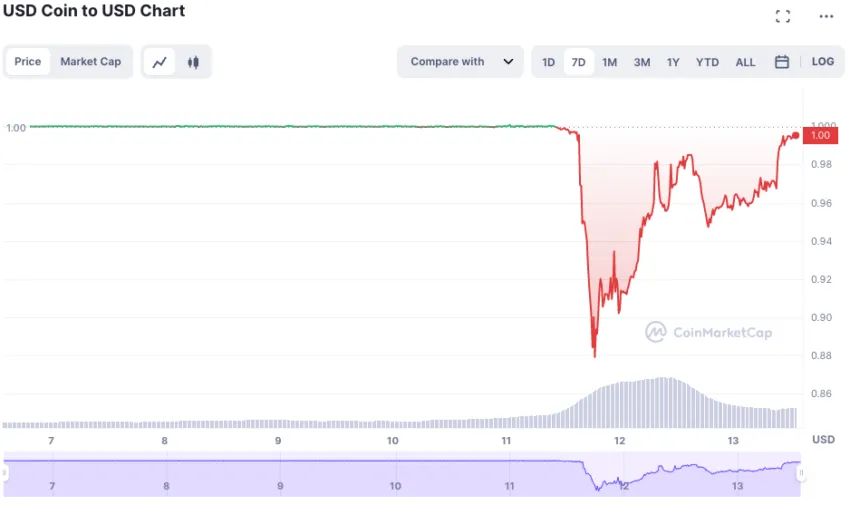Crypto receives a reminder of banks’ relevance

The closure of Silicon Valley Bank last week has sparked a period of unprecedented banking turmoil last seen during the 2008 Global Financial Crisis (GFC).
While 2020 was a nightmare year for most, it was a boom for the technology sector. People spent more time on their phones and computers, conferencing software came into its own, and new money and a hiring spree meant the sector was more vibrant than almost any other part of the economy.
Silicon Valley Bank (SVB), one of the leading banks in the technology sector, had $60 billion in customer deposits in the first quarter of 2020 and $200 billion by the first quarter of 2022. The good times were not to last.
Silicon Valley Bank is the biggest failure of a bank since 2008
However, the bank invested in government bonds and mortgage-backed securities, but suffered heavy losses when the Federal Reserve raised interest rates to combat rising inflation. Silicon Valley Bank sold assets to minimize losses. But when it announced it needed to raise $2.25 billion in capital, customers withdrew $42 billion in deposits. Regulators closed the bank the next day. It is the biggest failure of a US bank since the GFC of 2008.
However, on Sunday the US government announced that depositors would be able to access their cash from Monday. All depositors would be fully protected, allaying fears of a major crisis. The US Department of the Treasury, the Federal Reserve and the Federal Deposit Insurance Corporation (FDIC) have stated that the taxpayer will not bear any losses from the move.
Meanwhile, an offer has been made for SVB’s UK arm, with a consortium of investors led by the Bank of London submitting a formal bid to the UK Treasury. The UK government has been working on a plan to support UK technology firms affected by the collapse of SVB.
While Silicon Valley Bank was not as exposed to crypto as Silverware, it has already caused disruption in the industry.
USDC depegged after Silicon Valley Bank Collapse
Stablecoin USD Coin (USDC) fell to a low of $0.879 on CoinMarketCap. Circle, the company behind USDC, had $3.3 billion in exposure to SVB, raising concerns among investors that the stablecoin may not maintain its peg to the US dollar. Although $3.3 billion only accounts for $40 billion of the total USDC reserves.

“Silicon Valley Bank … has just undergone a classic bank run, much like the ones we saw during the 2008 financial crisis,” the company said in a blog post on Saturday. “$3.3 billion of USDC’s cash balance remains with SVB. As of Thursday, we had initiated transfers of these funds to other bank partners. Although these transfers had not yet been settled as of Friday, we are confident in the FDIC’s handling of the SVB situation and are ready to receive these funds.”
Why does a bank collapse affect the link to a stablecoin? Partly because USDC is fully reserve-backed. That means each USDC is backed by actual cash and short-dated US Treasuries. If any part of that reserve disappears or disappears – even temporarily – the market will lose confidence. Investors will worry about whether the stablecoin can retain its value.
And then there is Silvergate, whose collapse took place just days before the SVB turmoil.
Crypto-friendly banks had a nightmare week
The bank, which had high-profile clients such as Coinbase, Gemini, Paxos and Circle, blamed the collapse of Sam Bankman-Fried’s FTX exchange empire for its woes. The bank’s shares fell 20% after the Justice Department announced an investigation into the bank’s role in the collapse of FTX.
Silvergate’s collapse has left a hole in the US cryptocurrency industry, with many crypto exchanges struggling to move dollars into their trading accounts and move them into their bank accounts. Companies such as Coinbase, Crypto.com and Paxos quickly distanced themselves from the bank.
Unfortunately for crypto, Silvergate’s implosion is likely to draw more scrutiny from lawmakers. There is growing concern about the industry’s impact on traditional finance.
“As the impact of FTX’s collapse continues to ripple outward, today we see what can happen when a bank over-relies on a risky, volatile sector like cryptocurrencies,” said Sherrod Brown, a progressive US senator and chairman of the Senate Banking Committee. Housing and urban committee.
“I have been concerned that when banks get involved in crypto, it spreads risk across the financial system and it will be taxpayers and consumers who pay the price.”
After Silvergate announced its voluntary liquidation, blockchain companies approached Signature Bank. One of the last banks in the US to offer financial services to the volatile industry. However, two days after Silicon Valley Bank collapsed, the New York Department of Financial Services took possession of Signature Bank, which has deposits totaling $88.59 billion.
For crypto companies partnering with Signature, the announcement brings immediate relief that their deposits will be protected. But that leaves an open question as to where they will find banking services.
What about the bankless future?
So what about the fintech utopia that crypto promised? Why has the collapse of two banks sent the crypto markets into a tailspin? Wasn’t crypto meant to replace the traditional financial system?
It was, or it may still be. It all depends on who you ask. The cruel fact, however, is that crypto still exists in a wider financial system, of which traditional banks are a large part. And while your crypto principles mean you want to avoid interacting with banks as much as possible, the people investing in your company, those trading your token, and the other businesses you work with will have different ideas.
The “bankless” future many envisioned has almost come true this week. Although not quite the way people had imagined.
Traditional personal banking will of course be a must until you can pay for more goods and services in cryptocurrency.
Unfortunately for the cryptomaximists, traditional-style banks are the axles on which the wheel of the financial system spins. When they go down, crypto is inevitably affected.
Also, DeFi is simply not mature enough to replace banks quite yet. The total market cap for DeFi is less than $50 billion. While the traditional financial industry is measured in trillions of dollars. Until that reality changes, the crypto industry needs to pay attention to the importance of these financial giants.
Disclaimer
All information on our website is published in good faith and for general information purposes only. Any action the reader takes on the information contained on our website is strictly at their own risk.























